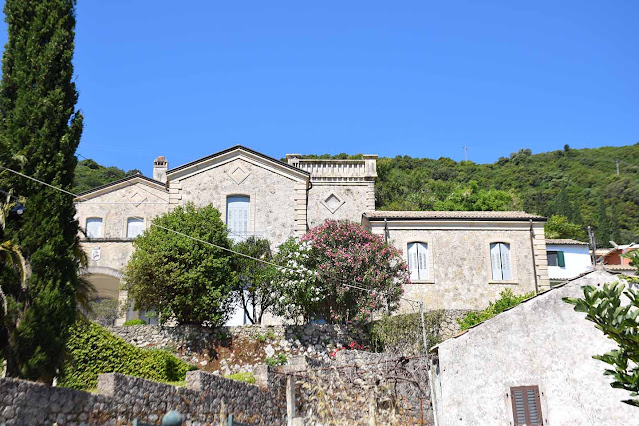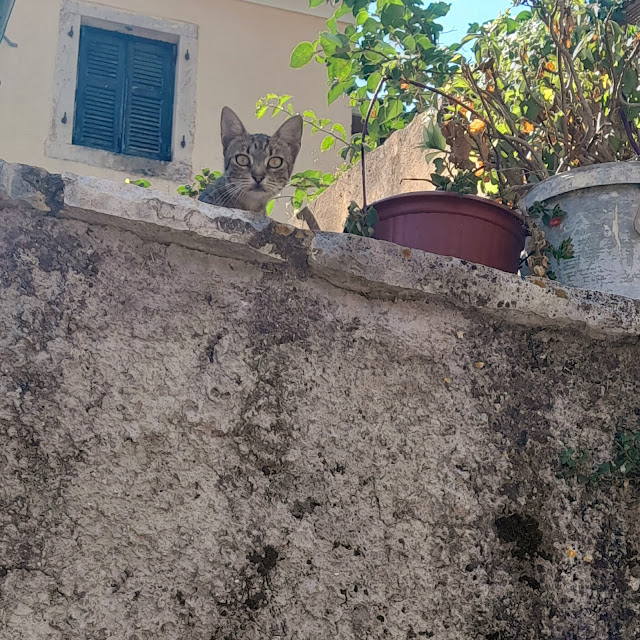Kalispera! I'm sure you're aware of the terrible wildfires currently raging in Rhodes, Athens and Corfu. We've heard from our dear friend George in Rhodes, the fires are really close to his home in Stegna but thankfully he, his family & friends are safe.
George is currently volunteering with the island's fire service & battling the flames and the photos he sent us over the weekend are truly horrific. I do hope that my travelogues inspire one or two readers to travel to Greece, this beautiful country relies on tourism and from what I've seen on the news and read on social media, unlike the big travel companies, the Greeks are going out of their way to assist travellers caught up in the tragedy offering lifts to the airport, refreshments and room in their homes.
Anyway, on to the last of my Corfu posts. This is Doukades, a traditional mountain village a five kilometre walk from Paleokastritsa. The settlement probably originated during a period of devastating pirate raids on Corfu’s coastal communities when people retreated to the more remote interior. The earliest written reference to Doukades is from 1616.
The Theotoki Mansion, said to be the most impressive house in the village was home to Georgios Theotokis, Prime Minister of Greece from 1899 - 1909.
 |
| Lady Jane Digby (1807 - 1881) - William Charles Ross |
Another resident of the Theokoti Mansion was Lady Jane Digby, a notorious aristocratic beauty who was born in Dorset in 1807. At 17, Lady Jane married Lord Ellenborough, the governor-general of India later scandalising English society by divorcing him and moving to Germany. After an affair with Ludwig I of Bavaria she married Baron Karl von Venningen of Munich before embarking on an affair with the Greek Count, Spyridon Theotokis. After a duel between her love rivals she divorced the baron, converted to the Greek Orthodox faith and married Spyridon. The couple moved to his family home in Doukades but divorced after their son Leonidas died after falling from a balcony. Lady Jane then went on to have an affair with Greece's King Otto before meeting General Christodoulos Hatziperos, hero of the Greek War for Independence, where she acted as his queen, living in caves, riding horses and hunting. Lady Jane then travelled to the Middle East and fell in love with Sheik Medjuel el Mezrab, who was twenty years her junior. The couple married under Muslim law and stayed together until her death 28 years later. Lady Jane adopted native dress, lived a nomadic lifestyle in tents in the desert and learned Arabic in addition to the eight languages in which she was already fluent.
Keen to know more? You can buy a secondhand copy of her biography, A Scandalous Life: The Biography of Jane Digby by Mary S Lovell HERE.
 |
| Lady Jane Digby by Joseph Karl Steiler (1831) |
Jane, herself a born gardener and a garden lover, celebrated her arrival at Doukades by planting a cypress tree in the grounds, It is still there, tall as a tower now, a dignified and delighted memorial to her - her only memorial in Greece. E. M. Oddie (1935)
On the approach to the village we passed a sign marking The Battle of Kratsalo (1403) where the local militia, aided by the Venetians, fought a bloody battle against Genoese invaders. Eventually the Genoese retreated, shouting This is another state! in broken Greek (Kratos + allo) which is said to be how Corfu's adjacent mountain range, Pantokrator, got its name.
There's three tavernas in the village square with Elizabeth's, established in 1960, being the highest rated. In more normal conditions (ie., below 45°) we'd have ventured out later and had lunch there but, keen to escape the hottest part of the day, our trip didn't coincide with opening hours. The perfect reason to go back!
Our guidebook recommended a viewing point at Saint Symeon so after leaving Doukades we wandered through some olive groves, passed a small monastery, marvelled at the rocks and were eventually rewarded with a vista to die for.

But that's ages away. It's back to the day job - festival trading - we're off to Womad in the morning! The wellies are packed and there's plenty of booze to help drown our sorrows if the weather really does turn out to be as miserable as expected plus Femi Kuti is amazing. Check him out HERE.
If you're going, look out for us in the main arena and come and say hello, it'd be lovely to meet you.
See you soon!

.jpg)












































.jpg)





















































